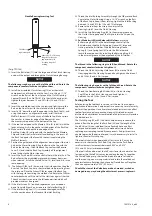
2
16575185_ed3
Product Safety Information
WARNING
Failure to observe the following warnings, and to avoid these potentially hazardous situations, could result in death or serious injury.
Read and understand this and all other supplied manuals before installing, operating, repairing, maintaining, changing accessories on, or
working near this product.
Always wear eye protection when operating or performing maintenance on this tool. The grade of protection required should be assessed
for each use and may include impact-resistant glasses with side shields, goggles, or a full face shield over those glasses.
Always turn off the air supply, bleed the air pressure and disconnect the air supply hose when not in use, before installing, removing or
adjusting any accessory on this tool, or before performing any maintenance on this tool or any accessory.
Note:
When reading the instructions, refer to exploded diagrams in Parts Information Manuals when applicable (see under Related Documentation
for form numbers).
•
•
•
•
Lubrication
Each time a Series QS Screwdriver is disassembled for maintenance
and repair or replacement of parts, lubricate the tool as follows:
1. Coat all exposed gears with
Ingersoll Rand
No. 67 Grease and
work some of the Grease into the gearing of the
Spindle Assembly (36).
2. Work approximately 6 to 8 cc of
Ingersoll Rand
No. 28 Grease
into the ball pockets, jaws, adjusting nut lock and shaft threads of
the clutch mechanism.
3. Use
Ingersoll Rand
No. 10 Oil to lubricate the motor. Inject
approximately 1 to 2 cc of oil into the air inlet before attaching
the air hose to the tool.
Speed Adjustment
In addition to adjustable clutches for controlling torque, Series QS
Inline Push-to-Start Screwdrivers are furnished with the ability to
precisely control speed, within certain ranges. Setting the speed
requires a tachometer.
Therefore, the adjustment, although simple, should only be
attempted by a competent technician using the proper equipment.
The Back Cap (5) has a small, molded stud on the end face of the Cap
nearest the Exhaust Diffuser (9). That stud controls the radial location
of the Diffuser which controls the opening size of the exhaust ports.
Take an initial reading of the tool speed by applying a tachometer
with a convex tip to the inside of the Bit Holder (77). Pressure against
the Bit Holder will activate the motor. Apply enough pressure to
bring the motor to maximum free speed. After determining the
actual velocity, shut off the air supply and disconnect the air line.
Use a 3/4” wrench to loosen the Inlet Bushing. The longest slot in
the Exhaust Diffuser will contain the molded stud on the Back Cap.
Rotate the Diffuser to open the exhaust ports to increase speed or
rotate it to restrict the exhaust to reduce speed. Being careful not to
allow the Diffuser to damage the molded stud, tighten the Inlet
Bushing to 15 ft.-lbs. (20 Nm) torque. Connect the air line and
restore the air supply and check the velocity again. Determine
which direction you need to rotate the Diffuser to obtain the desired
speed and then rotate it accordingly. Best results are achieved by
using gradual increments and frequent tachometer readings. Be
sure to turn off the air supply and disconnect the line when making
adjustments.
Disassembly
General Instructions
1. Do not disassemble the tool any further than necessary to replace
or repair damaged parts.
2. Do not press any needle bearing from a part unless you have a
new needle bearing on hand for installation. Needle bearings are
always damaged during the removal process.
3. When grasping a tool or part in a vise, always use leather-covered
or copper-covered vise jaws to protect the surface of the part
or tool and help prevent distortion. This is particularly true of
threaded members and housings.
4. Do not remove any part which is a press fit in or on a
subassembly unless the removal of that part is necessary for
repairs or replacement.
5. Do not disassemble the tool unless you have a complete set of
new gaskets and O-Rings for replacement.
Disassembly of the Tool
Each Series QS Push-to-Start Screwdriver is made using four modules
or units which include a motor housing unit, a motor unit, a clutch
with bit holder unit and a combined gearing with spindle unit. The
tool can be disassembled for repairs to each individual unit without
disturbing the other units. To separate the modules, proceed as
follows:
NOTICE
The thread in the following step is a left hand thread. Rotate the
Bit Finder or Housing Cap clockwise to remove it.
1.
For models with Bit Finder Bit Holders
, unscrew and remove
the Non-Rotating Bit Finder (84).
For models with Quick Release Bit Holders
, unscrew and
remove the Clutch Housing Cap (90). Use a thin blade screwdriver
to spiral the Retaining Ring (83) out of the groove in the end of
the Bit Holder (77). Being careful not to loose the Bit Retaining
Ball (78), slide the Spring Seat (82), Retaining Sleeve Spring (81)
and the Bit Retaining Sleeve (80) off the Bit Holder.
NOTICE
The thread in the following step is a left hand thread.
Rotate the Cover clockwise to remove it.
2. Unscrew and remove the Clutch Adjusting Hole Cover (89). There
are two sets of threads with a non-threaded section between
them on the Clutch Housing (75).
3. Using external retaining ring pliers or a thin blade screwdriver,
remove the Grip Retaining Ring (88) from the groove in the
Clutch Housing.
4. Pull the Housing Grip (85) off of the front end of the tool.
NOTICE
The thread in the following step is a left hand thread.
Rotate the Clutch Housing clockwise to remove it.
5. Using a 1-1/16” wrench on the flats of the Gear Case (37) and the
Clutch Housing Spanner Wrench (Part No. TRH 478) in the clutch
housing slot, unscrew and remove the Clutch Housing.
6. Push on the output end of the Bit Holder (77) to remove it from
the Clutch Housing (75).








